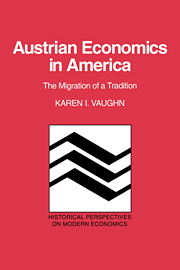Book contents
- Frontmatter
- Contents
- Preface
- Acknowledgments
- 1 Introduction
- 2 Carl Menger and the foundations of Austrian economics
- 3 Economic calculation and the rediscovery of Mengerian themes
- 4 Ludwig von Mises: Austrian economics in America
- 5 The Austrian revival
- 6 Defining the Austrian paradigm
- 7 Market process: the problem of order in Austrian economics
- 8 Austrian economics: which way forward?
- References
- Index
7 - Market process: the problem of order in Austrian economics
Published online by Cambridge University Press: 06 October 2009
- Frontmatter
- Contents
- Preface
- Acknowledgments
- 1 Introduction
- 2 Carl Menger and the foundations of Austrian economics
- 3 Economic calculation and the rediscovery of Mengerian themes
- 4 Ludwig von Mises: Austrian economics in America
- 5 The Austrian revival
- 6 Defining the Austrian paradigm
- 7 Market process: the problem of order in Austrian economics
- 8 Austrian economics: which way forward?
- References
- Index
Summary
During the period from 1974 to 1986, Israel Kirzner and Ludwig Lachmann were the acknowledged leaders of the new Austrian economics in America. They had been instrumental in sparking the Austrian revival, and they were the inspiration for most of the intellectual work that was done during those years. Both in the Ph.D. program and through the program of visiting appointments that Kirzner arranged at New York University, together Kirzner and Lachmann trained (and/or influenced) almost all of the younger economists who were to become identified with Austrian economics in some formal way. The New York University seminar and visiting program created an intellectual network of people who increasingly came to represent Austrian economics to the profession.
During their entire professional association, Kirzner and Lachmann continually engaged in a friendly and deeply respectful rivalry about the nature and implications of Austrian economics. Although rarely stated as such in their published work, it is clear both from their writings and their exchanges at conferences during this time that their arguments were often responses to issues and ideas proposed by the other. While they agreed on many specific issues, they differed most emphatically about the degree to which Austrian economics could be made consistent with neoclassical orthodoxy. Kirzner's approach was to incorporate Austrian insights within the context of the larger neoclassical paradigm whereas Lachmann was more inclined to jettison most of the orthodoxy as excess baggage in his search for a more fruitful way to theorize about social reality.
- Type
- Chapter
- Information
- Austrian Economics in AmericaThe Migration of a Tradition, pp. 139 - 161Publisher: Cambridge University PressPrint publication year: 1994

